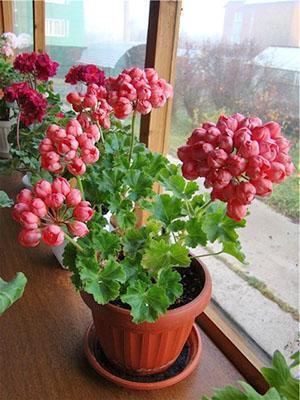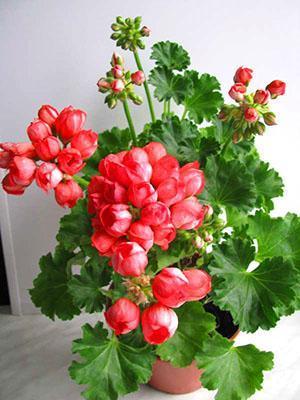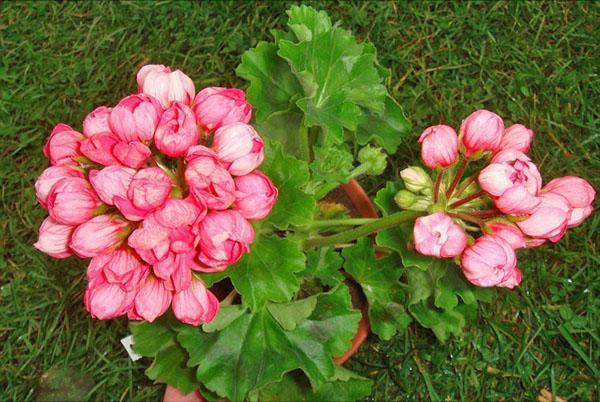The history of the appearance of tulip geranium and features of plant care
 Amazing geranium plants, on which, instead of lush umbrellas, inflorescences appear, more like elegant bouquets of tiny half-open tulips, were first introduced to culture fans in 1966.
Amazing geranium plants, on which, instead of lush umbrellas, inflorescences appear, more like elegant bouquets of tiny half-open tulips, were first introduced to culture fans in 1966.
50 years of tulip geranium history
This happened in the USA in the nursery of the Andrea family, where the tulip geranium was bred, so named for the shape of its unusual flowers.

European flower growers got acquainted with the tulip geraniums in the photo, only 20 years after the appearance of the first plants. Moreover, the flowers aroused not only genuine interest, but also a lot of controversy.
It is believed that tulip geraniums are difficult to select, and this is due to the structure of the flower and the low availability of stamens and pistil. Therefore, in half a century, no more than two dozen varieties and hybrids of these amazing plants have appeared in the world.
However, among specialists there is another explanation for the nature of the extraordinary shape of flowers. Perhaps this variety of geranium was not artificially bred, but was the result of a natural spontaneous mutation of some varieties of zonal geranium with simple flat corollas. Even the alleged ancestors of tulip varieties - ancient large-flowered geraniums obtained in France at the turn of the 19th and 20th centuries - were called skeptics of the success of the Andrea family nursery.
All currently existing geranium varieties with flowers in the form of miniature tulips are the subject of the dreams of amateur flower growers who are not indifferent to blooming decorative crops.
In this case, the plants are seriously different from each other. In the subgroup there are both tall specimens, the height of the shoots of which reaches 70–80 cm, but among the tulip geraniums there are also real dwarf hybrids and varieties. See also beautiful oleander flower photo!
 Plants differ in growth rate, color, shape and even the number of petals in the corolla. On average, each flower contains 6 to 9 petals, which can be straight or have curly jagged edges. The inner part of a centimeter rim is always more brightly colored than the one that faces outward. Lush bouquets-inflorescences of tulip geraniums, as in the photo, consist of 20-40 flowers. Read about tulip tree!
Plants differ in growth rate, color, shape and even the number of petals in the corolla. On average, each flower contains 6 to 9 petals, which can be straight or have curly jagged edges. The inner part of a centimeter rim is always more brightly colored than the one that faces outward. Lush bouquets-inflorescences of tulip geraniums, as in the photo, consist of 20-40 flowers. Read about tulip tree!
 Photos of tulip geraniums amaze with the variety of colors and decorativeness of plants with bright curly foliage. There are more and more people who want to become the owners of such plants every year.
Photos of tulip geraniums amaze with the variety of colors and decorativeness of plants with bright curly foliage. There are more and more people who want to become the owners of such plants every year.
Features of caring for tulip geraniums
In leaving, tulip geraniums are almost as picky as their relatives with regular flowers. With due care, they willingly bloom, grow and reproduce. For planting ornamental plants, you can use both a ready-made universal mixture, and prepare the substrate yourself, mixing garden soil in equal proportions, peat and a small amount of sand to make the soil loose.
Geraniums are afraid of waterlogging of the soil and stagnation of moisture in it, therefore, a powerful drainage layer is poured at the bottom of the pot.
 Planted plants should not lack sunlight all year round. Tulip geraniums feel best in bright, but diffused lighting. If you take care of backlight bushes, then inflorescences may appear in winter. In shaded places, the shoots of tulip geraniums weaken, stretch out. With a lack of sun, foliage becomes pale, part of the buds cannot form and open.
Planted plants should not lack sunlight all year round. Tulip geraniums feel best in bright, but diffused lighting. If you take care of backlight bushes, then inflorescences may appear in winter. In shaded places, the shoots of tulip geraniums weaken, stretch out. With a lack of sun, foliage becomes pale, part of the buds cannot form and open.
In the room, geraniums do not require special conditions of detention. The main thing is that in summertime the air is warmed up to 20-26 ° C, and the atmosphere is 5-7 ° C cooler. Plants do not tolerate drafts well, from which tulip geraniums are best protected. Dry hot air coming from heating devices is not good for flowering.
 In the warm season, when the need for moisture is high, tulip geraniums are watered every other day, making sure that the water does not stagnate. In winter, watering is carried out much less often, but in no case should you dry an earthen lump under a flower.
In the warm season, when the need for moisture is high, tulip geraniums are watered every other day, making sure that the water does not stagnate. In winter, watering is carried out much less often, but in no case should you dry an earthen lump under a flower.
Top dressing is carried out from spring to autumn, using liquid complex means with a low nitrogen content, otherwise the plant will give a lot of foliage, but the geranium bloom will not please with splendor
Like other varieties of flowering geraniums, tulip varieties need pruning and pinching. These operations are designed to:
- improve the shape of the bush;
- cause branching shoots;
- make the flower form more flower buds.
As a result, the plant looks more decorative and attractive, and it blooms much more magnificently than before pruning, included in the systematic care of tulip geraniums.
 In addition to pinching the tops of the shoots, it is necessary to remove the fading inflorescences and cut off the overgrown, immensely lengthening adult shoots.
In addition to pinching the tops of the shoots, it is necessary to remove the fading inflorescences and cut off the overgrown, immensely lengthening adult shoots.
Cut off tops are an excellent breeding material. Since tulip geranium seeds, as in the photo, are not always easy to find, and germination can cause problems for novice culture enthusiasts, cuttings have become the most common way to get new plants.
Cuttings are obtained in the spring or after the end of the mass flowering - in the fall. You can root geraniums in ordinary water, a light substrate of peat and sand, or in a solution of a root formation stimulator. After the first roots appear, the cutting is planted in the ground and exposed to a light window.
 The only feature of tulip geranium that a grower may encounter is the appearance of shoots with ordinary flowers. In this case, it is better to cut such a stem under the base. Similar surprises are not excluded when growing plants from cuttings. The tendency to spontaneous mutations suggests that the variety is not sufficiently fixed, but this does not detract from the decorativeness and amazing attractiveness of miniature "tulips".
The only feature of tulip geranium that a grower may encounter is the appearance of shoots with ordinary flowers. In this case, it is better to cut such a stem under the base. Similar surprises are not excluded when growing plants from cuttings. The tendency to spontaneous mutations suggests that the variety is not sufficiently fixed, but this does not detract from the decorativeness and amazing attractiveness of miniature "tulips".
like tulip geranium how to buy seeds
We do not sell seeds. Ask at your local flower shop. Also, many growers order seeds from online stores.
Please tell me, tulip-shaped pelargoniums always have slightly twisted leaves upward. I bought a rooted shoot and wondered if I was sick with anything. But the seller told me that this is such a feature in tulip
You were told correctly. In most varieties of tulip pelargonium, the leaves seem to curl upward.
I will add.
Tulip and rosebud pelargoniums DO NOT propagate by seeds. Only by cuttings.